Supervolcano
A supervolcano is a large volcano that has had an eruption with a Volcanic Explosivity Index (VEI) of 8, the largest recorded value on the index. This means the volume of deposits for that eruption is greater than 1,000 cubic kilometers (240 cubic miles).[1]



Supervolcanoes occur when magma in the mantle rises into the crust but is unable to break through it and pressure builds in a large and growing magma pool until the crust is unable to contain the pressure. This can occur at hotspots (for example, Yellowstone Caldera) or at subduction zones (for example, Toba). Large-volume supervolcanic eruptions are also often associated with large igneous provinces, which can cover huge areas with lava and volcanic ash. These can cause long-lasting climate change (such as the triggering of a small ice age) and threaten species with extinction. The Oruanui eruption of New Zealand's Taupo Volcano (about 26,500 years ago)[2] was the world's most recent VEI-8 eruption.
Terminology
The term "supervolcano" was first used in a volcanic context in 1949.[note 1]
Its origins lie in an early 20th-century scientific debate about the geological history and features of the Three Sisters volcanic region of Oregon in the United States. In 1925, Edwin T. Hodge suggested that a very large volcano, which he named Mount Multnomah, had existed in that region.[note 2] He believed that several peaks in the Three Sisters area were the remnants of Mount Multnomah after it had been largely destroyed by violent volcanic explosions, similar to Mount Mazama.[3] In 1948, the possible existence of Mount Multnomah was ignored by volcanologist Howel Williams in his book The Ancient Volcanoes of Oregon. This book was reviewed in 1949 by another volcanologist, F. M. Byers Jr.[4] In the review, Byers refers to Mount Multnomah as a supervolcano.[5]
More than fifty years after Byers' review was published, the term supervolcano was popularised by the BBC popular science television program Horizon in 2000, referring to eruptions that produce extremely large amounts of ejecta.[6][7]
The term megacaldera is sometimes used for caldera supervolcanoes, such as the Blake River Megacaldera Complex in the Abitibi greenstone belt of Ontario and Quebec, Canada.
Eruptions that rate VEI 8 are termed "super eruptions".[8] Though there is no well-defined minimum explosive size for a "supervolcano", there are at least two types of volcanic eruptions that have been identified as supervolcanoes: large igneous provinces and massive eruptions.[9]
Large igneous provinces

Large igneous provinces, such as Iceland, the Siberian Traps, Deccan Traps, and the Ontong Java Plateau, are extensive regions of basalts on a continental scale resulting from flood basalt eruptions. When created, these regions often occupy several thousand square kilometres and have volumes on the order of millions of cubic kilometers. In most cases, the lavas are normally laid down over several million years. They release large amounts of gases.
The Réunion hotspot produced the Deccan Traps about 66 million years ago, coincident with the Cretaceous–Paleogene extinction event. The scientific consensus is that a meteor impact was the cause of the extinction event, but the volcanic activity may have caused environmental stresses on extant species up to the Cretaceous–Paleogene boundary.[10] Additionally, the largest flood basalt event (the Siberian Traps) occurred around 250 million years ago and was coincident with the largest mass extinction in history, the Permian–Triassic extinction event, although it is unknown whether it was solely responsible for the extinction event.
Such outpourings are not explosive, though lava fountains may occur. Many volcanologists consider Iceland to be a large igneous province that is currently being formed. The last major outpouring occurred in 1783–84 from the Laki fissure, which is approximately 40 km (25 mi) long. An estimated 14 km3 (3.4 cu mi) of basaltic lava was poured out during the eruption (VEI 4).
The Ontong Java Plateau has an area of about 2,000,000 km2 (770,000 sq mi), and the province was at least 50% larger before the Manihiki and Hikurangi Plateaus broke away.
Massive explosive eruptions
Volcanic eruptions are classified using the Volcanic Explosivity Index, or VEI. It is a logarithmic scale, which means that an increase of one in VEI number is equivalent to a tenfold increase in volume of erupted material. VEI 7 or VEI 8 eruptions are so powerful that they often form circular calderas rather than cones because the downward withdrawal of magma causes the overlying rock mass to collapse into the empty magma chamber beneath it.
Known super eruptions
Based on incomplete statistics, at least 60 VEI 8 eruptions have been identified.[9][11] Below is a list of well-known super-eruptions.
| Name | Zone | Location | Notes | Years ago (approx.) | Ejecta bulk volume (approx.) | Reference |
|---|---|---|---|---|---|---|
| Wah Wah Springs | Indian Peak–Caliente Caldera Complex | Utah, United States | The largest of the Indian Peak-Caliente Caldera Complex eruptions, preserved as the Wah Wah Springs Tuff; includes pyroclastic flows more than 4,000 metres (13,000 ft) thick | 30,600,000 | 5,500–5,900 km3 | [12][13] |
| La Garita Caldera | San Juan volcanic field | Colorado, United States | Fish Canyon eruption | 27,800,000 | 5,000 km3 | [14][15] |
| Lake Toba | Lake Toba, North Sumatra | Sumatra, Indonesia | Produced 2200–4400 million tons of H2SO4 | 74,000 | 2,800 km3 | [16][17][18] |
| Huckleberry Ridge eruption | Yellowstone hotspot | Idaho, United States | Huckleberry Ridge Tuff; consisted of three distinct eruptions separated by years to decades | 2,100,000 | 2,450–2,500 km3 | [22][21] |
| Taupo Nui a tia | Taupo Volcanic Zone | North Island, New Zealand | Whakamaru Ignimbrite/Mount Curl Tephra | 340,000 | 2,000 km3 | [23] |
| Heise Volcanic Field | Yellowstone hotspot | Idaho, United States | Kilgore Tuff | 4,500,000 | 1,800 km3 | [24] |
| Heise Volcanic Field | Yellowstone hotspot | Idaho, United States | Blacktail Tuff | 6,000,000 | 1,500 km3 | [24] |
| Cerro Guacha | Altiplano-Puna volcanic complex | Sur Lípez, Bolivia | Guacha ignimbrite, two smaller eruptions identified | 5,700,000 | 1,300 km3 | [25] |
| Mangakino Caldera | Taupo Volcanic Zone | North Island, New Zealand | Kidnappers eruption | 1,080,000 | 1,200 km3 | [26] |
| Oruanui eruption | Taupo Volcanic Zone | North Island, New Zealand | Taupo Volcano (Lake Taupo) | 26,500 | 1,170 km3 | [27] |
| Cerro Galán | Andes Central Volcanic Zone | Catamarca, Argentina | Consisted of three distinct eruptions, separated by 30-40 thousands of years | 2,500,000 | 1,050 km3 | [28] |
| Lava Creek eruption | Yellowstone hotspot | Idaho, Montana, and Wyoming, United States | Lava Creek Tuff; consisted of two distinct eruptions separated by years | 640,000 | 1,000 km3 | [22][21][13] |
| Bishop Tuff | Long Valley Caldera | California, United States | A single eruption completed within 6 days; volume in dense rock equivalent | 760,000 | 600 km3 | [29] |
Media portrayal
- Nova featured an episode "Mystery of the Megavolcano" in September 2006 examining such eruptions in the last 100,000 years.[30]
Gallery
 Satellite image of San Salvador, El Salvador and the Lake Ilopango caldera (also known as the Dark Age volcano) in the Valley of the Hammocks, site of a VEI 6–8 eruption argued to be a cause for extreme weather events across the world in 535–536 AD.[31][32][33]
Satellite image of San Salvador, El Salvador and the Lake Ilopango caldera (also known as the Dark Age volcano) in the Valley of the Hammocks, site of a VEI 6–8 eruption argued to be a cause for extreme weather events across the world in 535–536 AD.[31][32][33]- Volcano, lake, and caldera locations in the Taupo Volcanic Zone
See also
- Global catastrophic risk – Hypothetical future events that could damage human well-being globally
- Timeline of volcanism on Earth
- Toba catastrophe theory – Supereruption 75,000 years ago that may have caused a global volcanic winter
- Volcanic winter – Temperature anomaly event caused by a volcanic eruption
- Volcanology of Io
References
- "Questions About Supervolcanoes". Volcanic Hazards Program. USGS Yellowstone Volcano Observatory. 21 August 2015. Archived from the original on 3 July 2017. Retrieved 22 August 2017.
- Wilson, C. J. N. (2001). "The 26.5ka Oruanui eruption, New Zealand: An introduction and overview". Journal of Volcanology and Geothermal Research. 112 (1–4): 133–174. Bibcode:2001JVGR..112..133W. doi:10.1016/S0377-0273(01)00239-6.
- Harris, Stephen (1988) Fire Mountains of the West: The Cascade and Mono Lake Volcanoes, Missoula, Mountain Press.
- Byers Jr., F. M. (1949) Reviews: The Ancient Volcanoes of Oregon by Howel Williams Archived 8 March 2016 at the Wayback Machine, The Journal of Geology, volume 57, number 3, May 1949, page 324. Retrieved 2012-08-17.
- supervolcano, n. Oxford English Dictionary, third edition, online version June 2012. Retrieved on 2012-08-17.
- Supervolcanoes Archived 1 August 2003 at the Wayback Machine. Bbc.co.uk (2000-02-03). Retrieved on 2011-11-18.
- USGS Cascades Volcano Observatory Archived 4 February 2012 at the Wayback Machine. Vulcan.wr.usgs.gov. Retrieved on 2011-11-18.
- de Silva, Shanaka (2008). "Arc magmatism, calderas, and supervolcanos". Geology. 36 (8): 671–672. Bibcode:2008Geo....36..671D. doi:10.1130/focus082008.1.
- Bryan, S.E. (2010). "The largest volcanic eruptions on Earth" (PDF). Earth-Science Reviews. 102 (3–4): 207–229. Bibcode:2010ESRv..102..207B. doi:10.1016/j.earscirev.2010.07.001.
- Keller, G (2014). "Deccan volcanism, the Chicxulub impact, and the end-Cretaceous mass extinction: Coincidence? Cause and effect?". Geological Society of America Special Papers. 505: 57–89. doi:10.1130/2014.2505(03). ISBN 9780813725055.
- BG, Mason (2004). "The size and frequency of the largest explosive eruptions on Earth". Bull Volcanol. 66 (8): 735–748. Bibcode:2004BVol...66..735M. doi:10.1007/s00445-004-0355-9.
- Tingey, David G.; Hart, Garret L.; Gromme, Sherman; Deino, Alan L.; Christiansen, Eric H.; Best, Myron G. (1 August 2013). "The 36–18 Ma Indian Peak–Caliente ignimbrite field and calderas, southeastern Great Basin, USA: Multicyclic super-eruptions". Geosphere. 9 (4): 864–950. Bibcode:2013Geosp...9..864B. doi:10.1130/GES00902.1.
- https://geology.com/stories/13/volcanic-explosivity-index/
- Ort, Michael (22 September 1997). "La Garita Caldera". Northern Arizona University. Archived from the original on 19 May 2011. Retrieved 5 August 2010.
- Lipman, Peter W. (2 November 2007). "Geologic Map of the Central San Juan Caldera Cluster, Southwestern Colorado". USGS Investigations Series I-2799. Archived from the original on 31 August 2010. Retrieved 6 August 2010. Cite journal requires
|journal=(help) - Petraglia, M.; Korisettar, R.; Boivin, N.; Clarkson, C.; Ditchfield, P.; Jones, S.; Koshy, J.; Lahr, M. M.; et al. (2007). "Middle Paleolithic Assemblages from the Indian Subcontinent Before and After the Toba Super-Eruption". Science. 317 (5834): 114–116. Bibcode:2007Sci...317..114P. doi:10.1126/science.1141564. PMID 17615356.
- Knight, M.D., Walker, G.P.L., Ellwood, B.B., and Diehl, J.F. (1986). "Stratigraphy, paleomagnetism, and magnetic fabric of the Toba Tuffs: Constraints on their sources and eruptive styles". Journal of Geophysical Research. 91 (B10): 10355–10382. Bibcode:1986JGR....9110355K. doi:10.1029/JB091iB10p10355.CS1 maint: multiple names: authors list (link)
- Ninkovich, D., Sparks, R.S.J., and Ledbetter, M.T. (1978). "The exceptional magnitude and intensity of the Toba eruption, Sumatra: An example of using deep-sea tephra layers as a geological tool". Bulletin Volcanologique. 41 (3): 286–298. Bibcode:1978BVol...41..286N. doi:10.1007/BF02597228.CS1 maint: multiple names: authors list (link)
- Rose, W.I. & Chesner, C.A. (1987). "Dispersal of ash in the great Toba eruption, 75 ka" (PDF). Geology. 15 (10): 913–917. Bibcode:1987Geo....15..913R. doi:10.1130/0091-7613(1987)15<913:DOAITG>2.0.CO;2. ISSN 0091-7613. Archived (PDF) from the original on 17 June 2010.
- Williams, M.A.J. & Royce, K. (1982). "Quaternary geology of the middle son valley, North Central India: Implications for prehistoric archaeology". Palaeogeography, Palaeoclimatology, Palaeoecology. 38 (3–4): 139. Bibcode:1982PPP....38..139W. doi:10.1016/0031-0182(82)90001-3.
- https://www.usgs.gov/faqs/what-a-supervolcano?qt-news_science_products=0#qt-news_science_products
- Global Volcanism Program | Volcanoes of the World | Large Holocene Eruptions Archived 13 February 2010 at the Wayback Machine. Volcano.si.edu. Retrieved on 2011-11-18.
- Froggatt, P. C.; Nelson, C. S.; Carter, L.; Griggs, G.; Black, K. P. (13 February 1986). "An exceptionally large late Quaternary eruption from New Zealand". Nature. 319 (6054): 578–582. Bibcode:1986Natur.319..578F. doi:10.1038/319578a0.
The minimum total volume of tephra is 1,200 km3 but probably nearer 2,000 km3, ...
- Lisa A. Morgan & William C. McIntosh (2005). "Timing and development of the Heise volcanic field, Snake River Plain, Idaho, western USA". GSA Bulletin. 117 (3–4): 288–306. Bibcode:2005GSAB..117..288M. doi:10.1130/B25519.1. S2CID 53648675.
- Salisbury, M. J.; Jicha, B. R.; de Silva, S. L.; Singer, B. S.; Jimenez, N. C.; Ort, M. H. (21 December 2010). "40Ar/39Ar chronostratigraphy of Altiplano-Puna volcanic complex ignimbrites reveals the development of a major magmatic province". Geological Society of America Bulletin. 123 (5–6): 821–840. Bibcode:2011GSAB..123..821S. doi:10.1130/B30280.1.
- Rejuvenation and Repeated Eruption of a 1.0 Ma Supervolcanic System at Mangakino Caldera, Taupo Volcanic Zone, New Zealand American Geophysical Union, Fall Meeting 2012, abstract #V31C-2797. Retrieved 10 September 2017.
- Wilson, C. J. N (1 December 2001). "The 26.5ka Oruanui eruption, New Zealand: an introduction and overview". Journal of Volcanology and Geothermal Research. 112 (1): 133–174. doi:10.1016/S0377-0273(01)00239-6. ISSN 0377-0273.
- Kay, Suzanne Mahlburg; Coira, Beatriz; Wörner, Gerhard; Kay, Robert W.; Singer, Bradley S. (1 December 2011). "Geochemical, isotopic and single crystal 40Ar/39Ar age constraints on the evolution of the Cerro Galán ignimbrites". Bulletin of Volcanology. 73 (10): 1487–1511. doi:10.1007/s00445-010-0410-7. ISSN 1432-0819.
- Hildreth, Wes; Wilson, Colin J. N. (1 May 2007). "Compositional Zoning of the Bishop Tuff". Journal of Petrology. 48 (5): 951–999. doi:10.1093/petrology/egm007. ISSN 0022-3530.
- "Mystery of the Megavolcano" Archived 17 June 2017 at the Wayback Machine. Pbs.org. Accessed on 2017-10-12.
- Dull, R., J.R. Southon, S. Kutterolf, A. Freundt, D. Wahl, P. Sheets; Southon; Kutterolf; Freundt; Wahl; Sheets (13–17 December 2010). "Did the TBJ Ilopango eruption cause the AD 536 event?". AGU Fall Meeting Abstracts. 13: V13C–2370. Bibcode:2010AGUFM.V13C2370D.CS1 maint: multiple names: authors list (link)
- Dull, R. A., Southon, J. R. & Sheets, P. (2001). "Volcanism, ecology and culture: a reassessment of the Volcán Ilopango TBJ eruption in the southern Maya realm". Latin American Antiquity. 12 (1): 25–44. doi:10.2307/971755. JSTOR 971755.CS1 maint: multiple names: authors list (link)
- Kutterolf, S. A. Freundt; W. Peréz (2008). "Pacific offshore record of plinian arc volcanism in Central America: 2. Tephra volumes and erupted masses". Geochemistry Geophysics Geosystems. 9, Q02S02 (2): n/a. Bibcode:2008GGG.....902S02K. doi:10.1029/2007GC001791.
Further reading
- Mason, Ben G.; Pyle, David M.; Oppenheimer, Clive (2004). "The size and frequency of the largest explosive eruptions on Earth". Bulletin of Volcanology. 66 (8): 735–748. Bibcode:2004BVol...66..735M. doi:10.1007/s00445-004-0355-9.
- Oppenheimer, C. (2011). Eruptions that shook the world. Cambridge University Press. ISBN 978-0-521-64112-8.
- Timmreck, C.; Graf, H.-F. (2006). "The initial dispersal and radiative forcing of a Northern Hemisphere mid-latitude super volcano: a model study". Atmospheric Chemistry and Physics. 6 (1): 35–49. Bibcode:2006ACP.....6...35T. doi:10.5194/acp-6-35-2006.
External links
- Overview and Transcript of the original BBC program
- Yellowstone Supervolcano and Map of Supervolcanoes Around The World
- USGS Fact Sheet – Steam Explosions, Earthquakes, and Volcanic Eruptions – What's in Yellowstone's Future?
- Scientific American's The Secrets of Supervolcanoes
- Supervolcano eruption mystery solved, BBC Science, 6 January 2014
